
Lake Waikareiti, also spelt Lake Waikare Iti, is located in Te Urewera National Park in the North Island of New Zealand. A number of hiking trails are found within the catchment basin of the lake.

Tmesipteris tannensis is a fern ally endemic to New Zealand. It is usually epiphytic on trees and tree ferns, but is occasionally terrestrial.
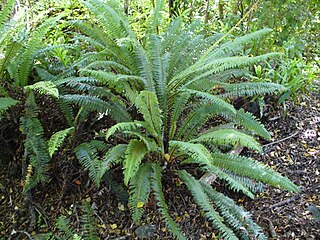
Lomaria discolor, synonym Blechnum discolor, commonly called crown fern, is a species of fern in the family Blechnaceae. This species is endemic to New Zealand. As noted by C. Michael Hogan, this species is found in a number of forest communities in diverse locations within New Zealand, and is sometimes a dominant understory component.

Dendroconche scandens, synonym Microsorum scandens, commonly called fragrant fern, is a species of fern within the family Polypodiaceae. This species is native to parts of New Zealand and Australia, as well as some offshore islands. It has been introduced to South Africa and Zimbabwe. An example occurrence in New Zealand's North Island is in the Hamilton Ecological District where it is associated with a number of other ferns including Icarus filiforme and Lomaria discolor.

Asplenium flaccidum is a species of fern in the family Aspleniaceae. The plant common name is drooping spleenwort or weeping spleenwort, and the species name flaccidum derives from the Latin root meaning drooping. An example occurrence of A. flaccidum is within a Nothofagus-Podocarp forest at Hamilton Ecological District on New Zealand's North Island in association with other fern species understory plants, crown fern, Blechnum discolor being an example.
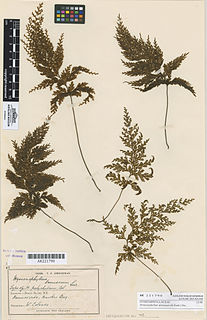
Hymenophyllum demissum is a species of fern in the family Hymenophyllaceae. H. demissum is found in New Zealand, with a specific example occurrence being in North Island's Hamilton Ecological District in a Nothofagus-podocarp forest in association with other fern species understory plants, crown fern, Blechnum discolor being an example.

Alseuosmia is a genus of five species of flowering plants in the family Alseuosmiaceae, growing in New Zealand's North Island. Species members are characteristically small evergreen shrubs. An example occurrence of species representative Alseuosmia macrophylla is in the habitat of the Hamilton Ecological District, where Blechnum discolor and B. filiforme are understory elements with a Nothofagus truncata and Dacrydium cupressinum overstory.

Alseuosmia macrophylla, the toropapa or karapapa, is a plant species in the family Alseuosmiaceae. This is a small evergreen shrub which is endemic to New Zealand, along with two closely related species. An example occurrence of A. macrophylla is in the North Island habitat of the Hamilton Ecological District, where Blechnum discolor and Blechnum filiforme are understory elements with Nothofagus truncata and rimu overstory. This plant is known for the pleasant scent of its flowers, and its family name translates as "perfumed grove". The small red berries of toropapa are edible and sweet tasting. As a forest understory plant, toropapa will not tolerate full sunlight or frost, and needs its roots to stay moist and cool, however so long as these conditions are met it is reasonably hardy, and is sometimes cultivated as a garden plant.
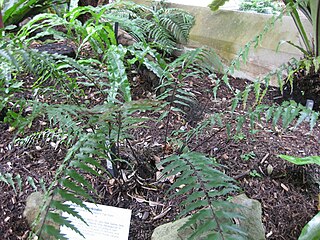
Asplenium polyodon, commonly known as sickle spleenwort, is a species of fern in the family Aspleniaceae. The distribution of A. polyodon includes parts of the countries of Australia and New Zealand. A specific locale of occurrence is in forested areas of Westland, New Zealand, where associate understory species include crown fern.

Metrosideros perforata, also known as white rata, climbing rata, akatea or Akatorotoro, is one of twelve Metrosideros species endemic to New Zealand. It is one of three white flowering rātā vines.

Coprosma rhamnoides is an endemic shrub in New Zealand. It forms a small shrub up to 2 m tall. The leaves are very small, simple and variable in shape. The inconspicuous flowers are unisexual and believed to be wind pollinated. It is widespread in occurrence and can be the dominant small leaved divaricating shrub in some locations
Astelia trinervia is a species of rhizomatous tufted perennial native to New Zealand. An example occurrence of this species is in the North Island's Hamilton Ecological District, where it occurs in the understory associated with Blechnum discolor and overstory forest elements of rimu and nothofagus trees.
Dicranoloma is a genus of mosses in the family Dicranaceae. The Dicranoloma mosses are distributed in the Southern Hemisphere, while the Dicranum mosses are found in the Northern Hemisphere. Species within this genus are dioicous. Another genus in this family is Campylopus. Example occurrences of the genus Dicranoloma is in the form of mats on beech/podocarp forest floors of New Zealand's northern South Island. Dicranoloma dicarpum has a wide distribution in both hemispheres.

The Spenser Mountains is a topographic landform in the northern South Island of New Zealand. Located at the southern end of the Nelson Lakes National Park and north of the Lewis Pass they form a natural border between the Canterbury and Tasman regions. Several peaks are named after characters in Edmund Spenser’s allegorical poem, The Faerie Queene. Many of the early explorers were evidently literate men. For example, Frederick Weld named Lake Tennyson; William Travers named the Spensers and Faerie Queene; Julius Haast named Mt Una.
The Sabine Valley is a landform in northern South Island, New Zealand. Much of the Sabine Valley is forested with beech canopy. Example understory vegetation is the presence of Archeria traversii within certain mountain beech forests in the upper Sabine Valley of northern South Island, New Zealand.
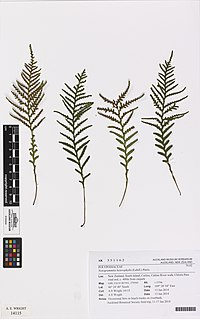
Notogrammitis heterophylla is a species of fern within the family polypodiaceae ferns. The species is found in New Zealand, Tasmania and Victoria, Australia. This plant is epiphytic In New Zealand's Westland N. heterophylla occurs in association with other epiphytes such as Asplenium polyodon and Trichomanes reniforme.
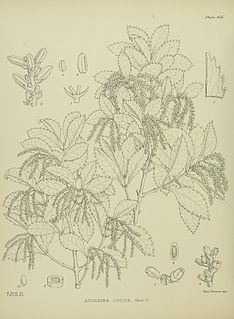
Ascarina lucida, commonly known as hutu is a species of small tree in the family Chloranthaceae. It is endemic to New Zealand, being common on the West Coast and Nelson regions of the South Island and more rarely found in the North Island. A typical plant association is within the Westland podocarp/broadleaf forests with common understory associates of Blechnum discolor, Pseudowintera colorata, Pseudopanax colensoi and Coprosma lucida. Most genus members are dioecious, producing unisexual male or female flowers on separate plants. Ascarina lucida, the only member of its genus to occur in New Zealand, is monoecious. It will grow to a height of 6m and can have a 30 cm trunk. The leaves which are in opposite pairs are simple, yellowish green in color, have a raised mid rib and are very similar to Laurelia novae-zelandiae. Their margins have prominent teeth which are dark colored at the tips. Ascarina lucida is now nearly extinct in the Taranaki region but was last reported in Oct 1969 at Mt Taranaki, near Pukeiti by Colin Ogle.
Pseudopanax colensoi is a species of evergreen plant. This species is native to New Zealand. An example occurrence in central Westland podocarp/broadleaf forests includes flora associates such as Cyathea smithii and Dicksonia squarrosa, Rumohra adiantiformis, Ascarina lucida, Pseudowintera colorata and Blechnum discolor. The maximum height of this plant is 5 meters and it is the preferred food of possums.
Pseudopanax edgerleyi is a species of plant which is native to New Zealand. An example occurrence in Westland District Podocarp/broadleaf forests includes flora associates such as Cyathea smithii, Dicksonia squarrosa and Blechnum discolor.
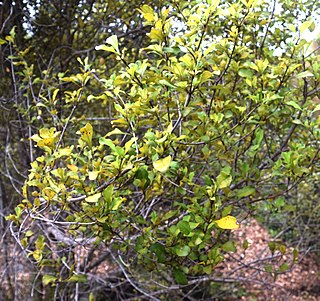
Coprosma arborea is a species found in New Zealand. The flowers have insignificant petals and are wind pollinated, with long anthers and stigmas. The fruit is a non-poisonous juicy berry, containing two small seeds. A typical occurrence location of the species is in the Hamilton Ecological District in New Zealand's North Island.














